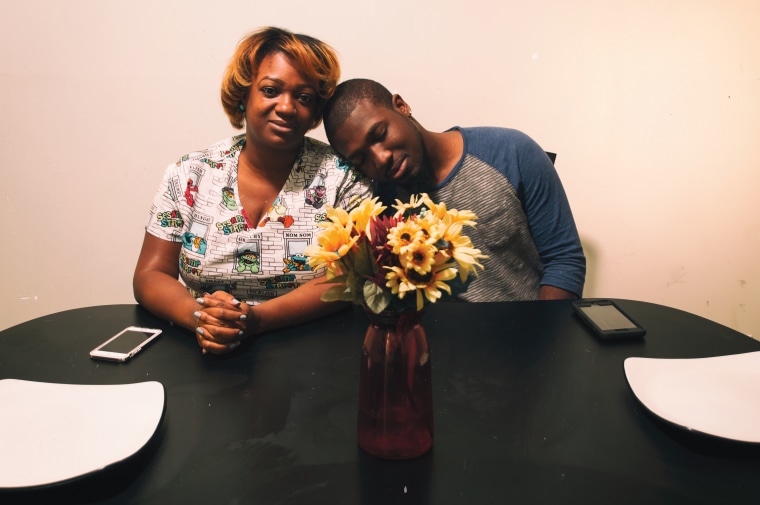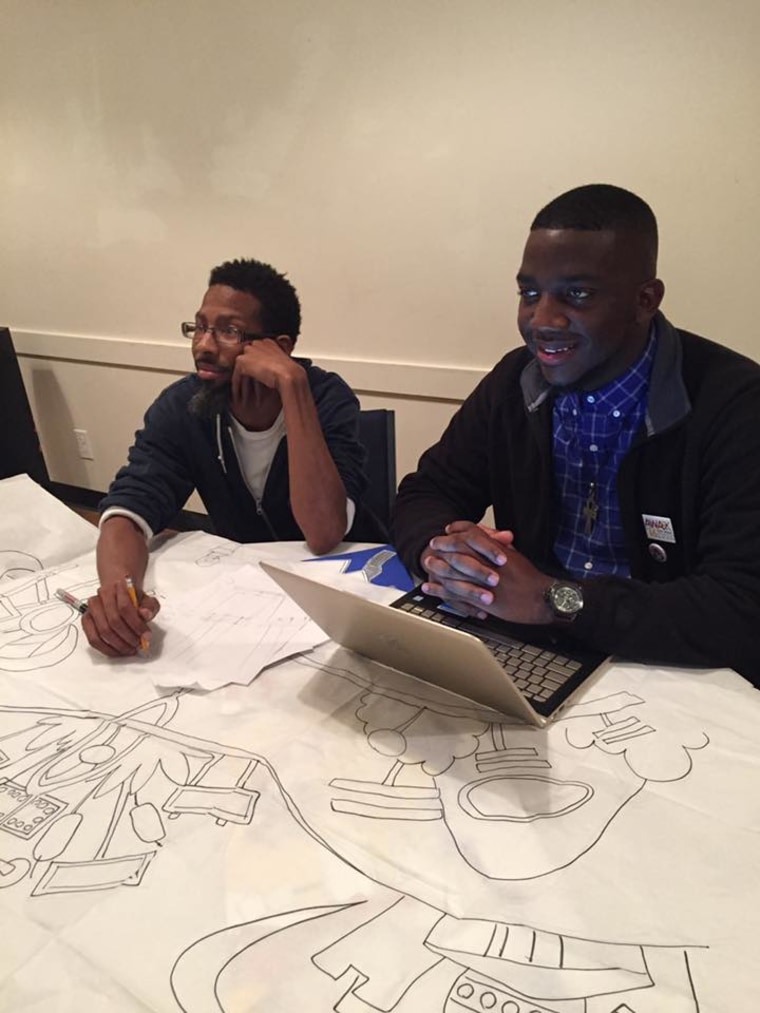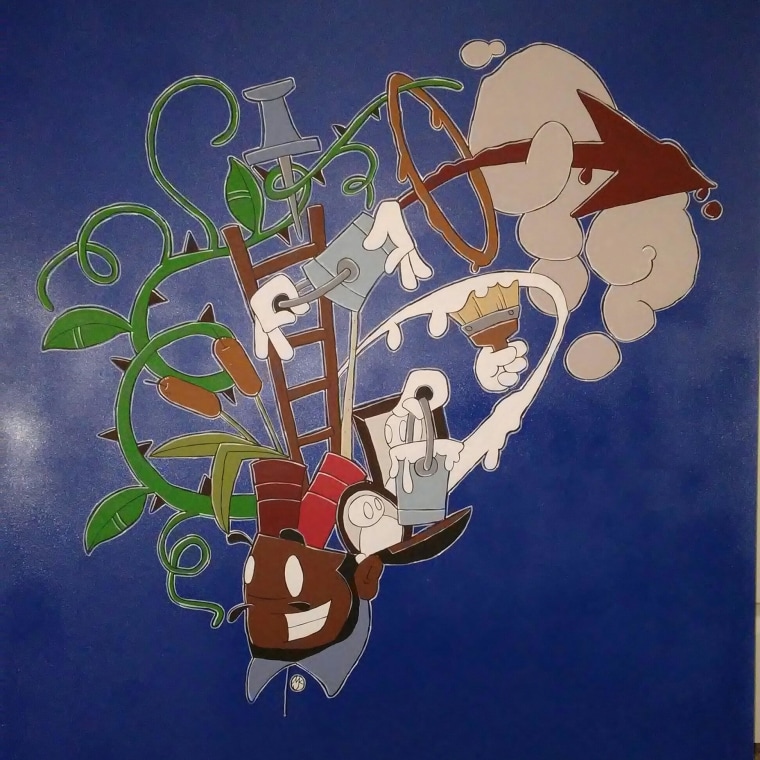Deontez Wimbley is HIV positive.
He had given blood while a student at Claflin University in South Carolina, and he learned of his status in the spring of 2012 through a letter in the mail from the Red Cross.
“The letter basically said that my blood was rejected because of a positive HIV test result,” he told NBC OUT. “I was scared and devastated at the news.”
Immediately, he thought to himself, “How did I let this happen?” He then wondered how he would tell his mother.

Now 24, Wimbley is back in Atlanta, living with his partner and working as the Atlanta-area Community Health Educator/Teen Action Group Coordinator for Planned Parenthood Southeast.
He is also one of five individuals being spotlighted as part of Georgia Equality’s World AIDS Day art exhibit, titled "Living With." The exhibit will debut at Gallery 874 in Atlanta on November 30 and be on display through World AIDS Day on December 1.
“Artists were matched one-on-one with youth living with HIV. They listen to their stories and create living quilt panels out of their lives,” said Emily Brown, Field Organizer for Georgia Equality. “The idea is to show that life goes on after a diagnosis. That a person not only has a past and present, but they also have a future, and a community, and a whole life, even if HIV is part of it.”

"Living With" gets its inspiration from the AIDS Memorial Quilt, according to Brown, who unofficially leads HIV advocacy programming for Georgia Equality. She said it has been some time since there has been a major art project that has mobilized people around HIV/AIDS in the way the Memorial Quilt had done.
“The AIDS Memorial Quilt was the largest community art project in history. It was a way to speak about the unspeakable human toll of this epidemic,” she told NBC OUT, adding that some may believe AIDS is a thing of the past, but it is not.
RELATED: Annie Lennox: 'AIDS Isn't Over...We Still Have a Long Way to Go'
“HIV is still here, and 50,000 people contract it every year in the U.S.,” she said. “In Georgia, 53,000 people are living with HIV. We need art that speaks to that, that people are living with HIV. That's where the name comes from.
According to Brown, artists were invited to submit concepts through a request for proposal process. The five that were selected were chosen based on the artistic strength of their proposal, their understanding of the realities faced by individuals impacted by HIV/AIDS and their ability to produce messaging that was anti-stigma.
“The selection committee then based the pairings on fit of concept and the story of the young person,” Brown added. “They were then asked to meet with subjects to get to know them, open a line of communication about the art.”
“The idea is to show that life goes on after a diagnosis. That a person not only has a past and present, but they also have a future, and a community, and a whole life, even if HIV is part of it.”
Jay Ray, an Atlanta based photographer and storyteller from Chester, Pennsylvania, was paired with Wimbley.
“Interestingly enough, I had met him a couple months prior during a training for Georgia Equality’s Youth HIV Policy Advisory board,” Jay Ray told NBC OUT. “When we were able to connect for this project, we began by simply getting to know one another.”
Jay Ray invited Wimbley to his home just to hang out. They didn't do any work, they just connected in a way that Jay Ray said was perfect for him.
“I love to connect with people over food,” he stated.
Wimbley got involved in the project through the suggestion of a friend. He said the project’s commitment to highlighting the voices and lives of people living with HIV is what drew him to the idea of contributing.
“Humanization aids in destigmatizing the virus,” Wimbley said. “It is important for me to tell my story. My story works to humanize people living with HIV.”
It is also what has been the driving force for Jay Ray in telling Wimbley’s story, which he does through a combination of video, audio recordings and photographs.
“I am a storyteller, so this is right up my alley,” he said. “Deontez said something to me very interesting one day at his place. He said, ‘When we talk about anti-HIV stigma, what we are talking about is that my life is no different from yours. The only difference is that I am a person living with HIV. When I come home, I cook dinner like you cook dinner, with my partner.’ His diagnosis is not talked about directly in my installation. It shows up in parts; but what I do put on display in the exhibit is his life, his humanness. And his relationship with his mother and his relationship with his boyfriend.”

Myke Johnson, 38, had the same motivation for his subject, Mahlon Randolph. A painter and illustrator, Johnson is telling Randolph’s story through storyboarding set into a board game.
“It was important for me to tell Mahlon’s story in this way, so that he knows someone has his back,” Johnson told NBC OUT. “My installation is a gigantic love letter to him, because he deserves to be celebrated; and the ups and downs of his story, of being abandoned, being homeless and surviving, need to be told.”
Johnson, who is also HIV-positive, said his experiences have been very different from many others living with the virus. Raped at the age of 19, he was infected with HIV and has struggled since from post-traumatic stress disorder. When he told his parents of his diagnosis, he said his father immediately hung up the phone –- but then called back five minutes later to express him unconditional love and support.
“For five minutes I felt like my world had come to an end,” he said. “But that was just five minutes. Mahlon’s family has abandoned him. Getting to know him, I cannot see how anyone would want to throw him away. This young man is on the threshold of manhood, and while I do not understand all that he has been through, this is my way of letting him know that I at least have his back.”
In addition to the installations by Jay Ray and Johnson, there are also installations by some of the youth in the Georgia Equality Youth HIV Policy Advisors program as well as bodies of work by Larry Walker, Robert Sherer, Larry Jens Anderson, Tony Bayles and John Burnett.
According to Brown, some of the artwork will go back to the artists while other pieces may be used in Georgia Equality's HIV policy advocacy later on in the legislative session or in community mobilization efforts. Some of the subjects may even be able to keep some of the artwork from the installations inspired by their stories.
Wimbley hopes when the exhibit closes there will be a push for policies that decriminalize HIV, ratify sex education and reform housing programs for people living with HIV.
“Moving forward I would love to be an advocate for pushing legislation through the state assembly,” he said.
Jay Ray hopes that what people will take away is that relationships matter.
“I want people to think about their lives,” he said. “I want people to know we are all living here together, and in order to live with each other, we have to fully accept one another and not stigmatize each other based on anything which includes HIV status. We need the art community involved in this fight.”

